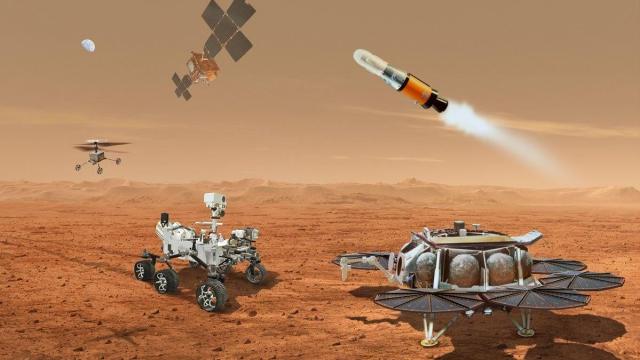NASA is considering alternative ways to bring back samples from Mars after its budget and schedule for the sample return mission was deemed unrealistic in a recent report by an independent review board.
During a meeting of the Mars Exploration Program Analysis Group held earlier this week, NASA announced the formation of a response team to address findings from a report, aiming to develop a revised architecture for the Mars Sample Return mission, SpaceNews reported. The team includes five subcommittees, each focused on a different issue mentioned in the report whether technical, budgetary or programmatic.
In late September, an independent review board issued its final report on NASA’s Mars Sample Return mission (MSR). The space agency’s quest to collect samples from the Red Planet and bring them back to Earth was referred to as a “highly constrained and challenging campaign,” with “unrealistic budget and schedule expectations from the beginning.”
The Sample Return mission involves a group of robots, landers, and orbiters working on and off Mars. NASA’s Perseverance rover is currently collecting rocky samples before stowing them away for a Sample Retrieval Lander to load them up onto a small rocket, from which they will be launched towards another spacecraft in orbit around Mars that is designed to drop them off at Earth in the mid 2030s.
NASA has been struggling to manage the budget of its highly complex mission so that it can launch it on schedule. In fact, the report stated that there’s a “a near zero probability” that the lander and orbiter would be ready for launch in 2028. The report also suggested that the mission’s full lifecycle cost will likely range between $US8 billion and $US11 billion, far more than what NASA had originally planned for.
The mission received $US822.3 million in the 2023 spending bill and NASA requested $US949.3 million for Mars Sample Return in its budget proposal for 2024. In April, NASA Administrator Bill Nelson revealed that the Mars Sample Return mission needs an additional $US250 million in the current fiscal year, plus another $US250 million in 2024, in order to stay on track for launch in 2028.
Despite its mounting cost and schedule delays, NASA remains committed to MSR, and the newly formed response team is trying to find a path forward for the mission given the bleak assessment made by the review board. “We’re looking to harvest as much of the work that we’ve done to date as possible, but also stepping back and looking at ways we can reduce cost and increasing resilience,” Jeff Gramling, MSR director at NASA, is quoted in SpaceNews as saying.
The response team will come up with two or three alternative architectures for the mission by March 2024. Once NASA selects a new architecture, the space agency will make formal cost and schedule commitments for the program and get a confirmation review by late 2024, according to SpaceNews.
One of the alternative options outlined in the report suggest launching the lander and the orbiter on separate dates, while another suggestion would hand off the responsibility of the orbit entirely to the European Space Agency (NASA’s partner on the mission).
Gramling also suggested reducing the quantity of samples returned from Mars, which would result in a smaller container built to house the samples and, therefore, a smaller spacecraft assigned to bring them back to Earth. A smaller spacecraft could reduce cost and complexity for the overall architecture, according to Gramling.
Despite giving it a bad review for execution, the report did highlight the importance of the mission. “A successful MSR campaign will revolutionize our understanding of the history of Mars, the Solar System, and the potential for life beyond Earth,” the report read.
For that reason, NASA is moving forward with its plan to return samples from Mars while also trying not to have it impact the rest of the space agency’s scientific endeavours.
